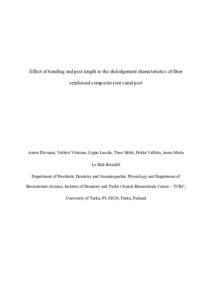Effect of bonding and post length to the dislodgement characteristics of fiber reinforced composite root canal post
Elovaara, Anton; Virtanen, Valtteri (2019-05-21)
Effect of bonding and post length to the dislodgement characteristics of fiber reinforced composite root canal post
Elovaara, Anton
Virtanen, Valtteri
(21.05.2019)
Julkaisu on tekijänoikeussäännösten alainen. Teosta voi lukea ja tulostaa henkilökohtaista käyttöä varten. Käyttö kaupallisiin tarkoituksiin on kielletty.
avoin
Julkaisun pysyvä osoite on:
https://urn.fi/URN:NBN:fi-fe2019052817449
https://urn.fi/URN:NBN:fi-fe2019052817449
Tiivistelmä
Purpose: The aim of this in vitro study was to investigate the forces needed to dislodge bonded and mechanically attached individually formed fiber-reinforced composite (FRC) posts from a simulated root canal.
Materials and Methods: Two different groups of FRC posts were made. The first group simulated bonded individually formed FRC posts and the second group simulated mechanically attached individually formed FRC posts to a root canal. The fiber post material in both groups (everStick Post, GC Corporation) consisted of unidirectional E-glass fiber reinforcement in a semi-interpenetrating polymer network (IPN) polymer matrix. The fiber material was formed into posts (diameter of 1.5-1.6 mm) by rolling it between two microscope glasses and light-polymerizing it. Different post lengths were made. Artificial root canals were made by drilling holes in polymethylmethacrylate (PMMA) blocks. The final post lengths inside the blocks in both groups were: 2, 3, 4 and 6 mm (n= 6/length). FRC posts in the blocks were tested with a 2-point bending test where the load was applied 0.5 mm from the end of the post.
Results: Both length and bonding had a significant effect on the dislodgement force (p < 0.001). The shortest posts differed statistically significantly from the other post lengths (p< 0.05). Greater force was needed to dislodge bonded FRC posts compared to not bonded FRC posts in every tested post length. The minimum post length inside the artificial root canal to achieve adequate mechanical retention, i.e. without bonding to simulated root was 3 mm.
Conclusion: This study highlighted the importance of good bonding of FRC posts to root canal.
Materials and Methods: Two different groups of FRC posts were made. The first group simulated bonded individually formed FRC posts and the second group simulated mechanically attached individually formed FRC posts to a root canal. The fiber post material in both groups (everStick Post, GC Corporation) consisted of unidirectional E-glass fiber reinforcement in a semi-interpenetrating polymer network (IPN) polymer matrix. The fiber material was formed into posts (diameter of 1.5-1.6 mm) by rolling it between two microscope glasses and light-polymerizing it. Different post lengths were made. Artificial root canals were made by drilling holes in polymethylmethacrylate (PMMA) blocks. The final post lengths inside the blocks in both groups were: 2, 3, 4 and 6 mm (n= 6/length). FRC posts in the blocks were tested with a 2-point bending test where the load was applied 0.5 mm from the end of the post.
Results: Both length and bonding had a significant effect on the dislodgement force (p < 0.001). The shortest posts differed statistically significantly from the other post lengths (p< 0.05). Greater force was needed to dislodge bonded FRC posts compared to not bonded FRC posts in every tested post length. The minimum post length inside the artificial root canal to achieve adequate mechanical retention, i.e. without bonding to simulated root was 3 mm.
Conclusion: This study highlighted the importance of good bonding of FRC posts to root canal.
